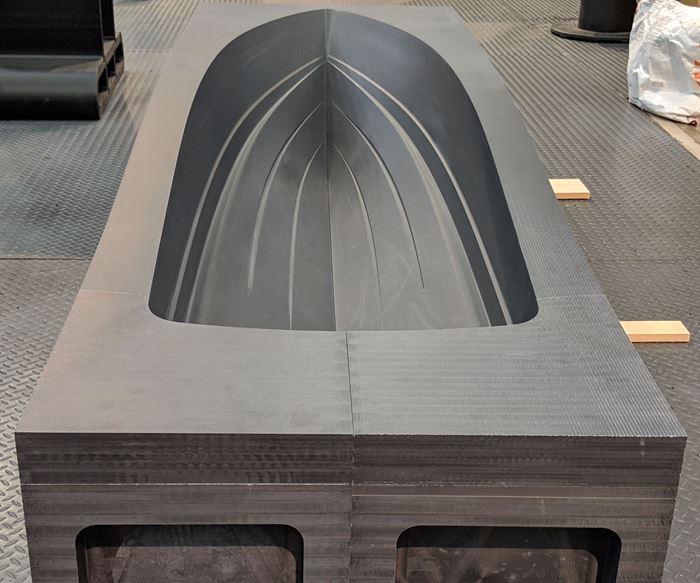Thermwood Validates 3D-Printed Yacht Hull Molds
A 3D-printed scale model of a hull mold will enable Thermwood to test and validate additive manufacturing for producing this tooling.
Share
Read Next
Full-sized patterns can be 3D printed to produce molds for sport boat hulls, but larger vessels like yachts require a different approach. In these instances, it is desirable to print the mold itself rather than print a plug or pattern from which a mold is made.
Working with an undisclosed marine industry collaborator, Thermwood says it has 3D-printed a scale model of such a hull mold to test and validate the process.
The 1/7th scale test mold for this project is approximately 7 ft. long (the full-size hull measures approximately 50 ft. long). It was printed from 20 percent carbon fiber-filled ABS using Thermwood’s LSAM additive manufacturing machine.
Six separate pieces of different lengths, the longest two being more than 7 ft. long, were printed concurrently using LSAM’s Vertical Layer Print capability. Printing required about 30.5 hours. The ability to simultaneously print multiple parts of variable heights is enabled by the flexibility of both the vertical print process as well as Thermwood’s LSAM Print3D slicing software, the company says. The parts were then trimmed on the same machine and assembled into two mold halves.
The tool includes a deep undercut at the transom, so the finished mold would be two pieces, split down the middle. These mold halves are clamped together for layup and then separated to remove the finished hull after curing.
Molds for hulls of longer than 50 ft. will be printed in multiple sections, assembled for hull layup and then disassembled to remove the finished part. The test tool printed here simulates that assembly and disassembly process.
The tool printed in this program will be tested using production materials in a production environment. Thermwood continues to work on methods and techniques needed to refine this into a production ready process.
Thermwood believes that the marine industry will benefit significantly from emerging large scale additive manufacturing technology and that this project is a significant first step toward the direct production of large vessel tooling.
Related Content
-
In Casting and Molding, AM Simplifies Conventional Manufacturing
In new ways, additive processes are streamlining and enabling metal casting and plastic injection molding.
-
In "Hybrid" FIM Process, 3D Printing Complements Injection Molding
In a recent case study, Alpine Advanced Materials partnered with Nexa3D to produce 3D printed tooling for injection molded composites. Utilizing Nexa3D’s XiP desktop 3D printer and its Freeform Injection Molding process, Alpine was able to reduce prototype tooling production time and cost alike for its customers.
-
Complete Speaker Lineup Announced for the 3D Printing Workshop at NPE2024: The Plastics Show
Presentations will cover 3D printing for mold tooling, material innovation, product development, bridge production and full-scale, high-volume additive manufacturing.
















